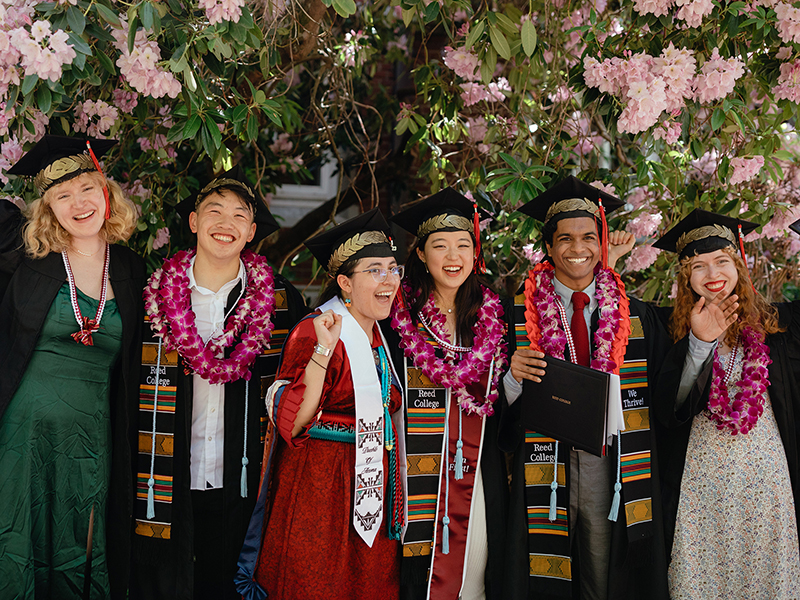Using the right photo on your web page is critical to communicating Reed's brand, creating the best user experience, and ensuring that we comply with photo usage laws.
To see recommended image dimensions for each component type, review the Image Specifications guide. For information on uploading, saving, and replacing photos in Cascade, check out the Add, Edit & Replace Images tutorial.
Image Considerations
Photography is a key component in a successful website relaunch. In general, the photography style should be clean, bright, and colorful with natural lighting, a genuine feel, and optimistic attitude. Images with people should include more than one person whenever possible. Outdoor shots should have sunny—rather than gray—skies whenever possible. Photos can be broken down into four categories: Academic, Campus Life, Portraits, and Campus Environment.
Academic
Academic photos should show students pursuing their passions, student and faculty collaboration, and engaged classroom learning.
Campus Life
Photographs of campus life, cocurricular activities, and extracurricular activities should capture the college experience, including areas outside of the classroom. Information about campus activities like recreation, fine arts, leadership, and community engagement should utilize images that define the culture and distinguishing characteristics of Reed College.
Portraits
Portraits of students and faculty used for spotlight stories or testimonials can be featured in a variety of communications.
Campus Environment
Campus environment photography should highlight the student experience within Reed’s unique architecture and the surrounding campus environment. The idea is to capture a sense of community in the context of facilities and spaces. Shots should be wide and expansive with multiple individuals socializing, studying, or moving through the spaces.
How to Select Photos
Follow these guidelines when choosing photos that will appear on the Reed College website:
- Browse Reed’s Smugmug account.
- If looking for photos of a particular subject, event, or space that is not on Smugmug, request assistance by filling out an intake form for photography use.
- Stock photography from online sources should only be used when completely necessary. Reach out to public affairs with any questions.
What you must do when selecting a photo for your page:
- Ensure that the photo is publicly available and has no known copyright. View our rights and usage section for more information.
- Size the image correctly, including specifications and files size. View our sizing guide for each type of photo on Reed's website. Since each image is a file that needs to be downloaded by the browser, the smaller those files are, the faster they will appear on the page (and thus the faster your page will load, giving your audience a better experience).
- Name the file using a naming protocol. For example, reed-new-students-orientation-outdoor-club (for an image to be placed on the Orientation page of the “new students” site that features students at an outdoor club event). For additional information, see the Add, Edit & Replace Images tutorial.
- Describe images with "alt text" to convey the content and meaning of an image to a visually impaired user. Learn more about alt text in our accessibility guide.
Reed Photography Policies
Photo editing
Alteration of a photograph that misleads, confuses, or otherwise misrepresents its accuracy is strictly prohibited. Enhancing the technical quality of photography is acceptable, but changing the meaning is not.
Demographic representation
Reed College photo usages should strive to be honest and authentic in the college’s demographic representation, while also aspiring to be as inclusive as possible without creating harm.
Images with text
Images that have text embedded onto them are not accessible since screen reading software is not able to distinguish the text as such. Logos, event titles, and names should be left off images but included in captions and alt descriptions.
Rights and usage
There will be instances in which Reed-specific photography is unavailable or not applicable. In this circumstance, the guidelines below are important to follow.
- Do not copy images from the web or elsewhere that may be subject to copyright. See Reed’s guide on copyright for using digital materials in courses.
- Unless you're using an image that has been published under a Creative Commons Zero (CC0) license—also known as "No Rights Reserved"—licensing or attribution is a legal requirement. Images that have been designated as "public domain" have no known copyright and are an exception as well.
- The creative commons website links to a number of websites dedicated to CC0.
- Public domain images can be found on many outlets. Some notables include:
The Library of Congress | NYPL Digital Archives - Images on each Reed College webpage are the responsibility of that page’s Reed owner. If images are found to be in violation of copyright, all incurred fees will be the responsibility of that page’s Reed owner.


